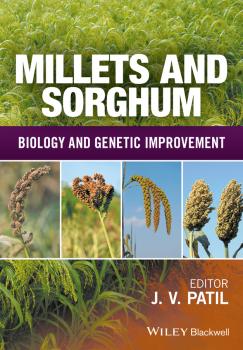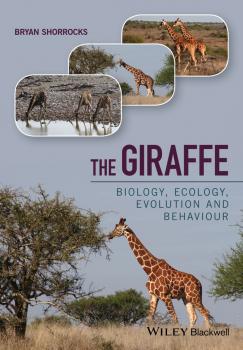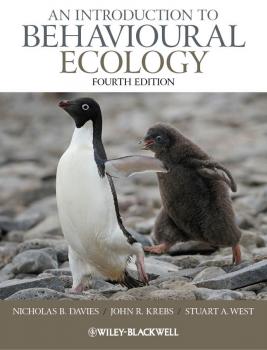Биология
Различные книги в жанре БиологияMicrobial Plant Pathogens. Detection and Management in Seeds and Propagules
Healthy seeds and propagules are the basic requirement for producing good grains, fruits and vegetables needed for human survival and perpetuation. Dispersal of microbial plant pathogens via seeds and propagules has assumed more importance than other modes of dispersal, as infected seeds and propagules have the potential to become the primary sources of carrying pathogen inoculum for subsequent crops. Several diseases transmitted through seeds and propagules have been shown to have the potential to damage economies as a result of huge quantitative and qualitative losses in numerous crops. Hence, it is essential to rapidly detect, identify and differentiate the microbial plant pathogens present in seeds and propagules precisely and reliably, using sensitive techniques. Microbial Plant Pathogens: Detection and Management in Seeds and Propagules provides a comprehensive resource on seed-borne and propagule-borne pathogens. Information on the biology of microbial pathogens, including genetic diversity, infection process and survival mechanisms of pathogens and epidemiology of diseases caused by them, are discussed critically and in detail to highlight weak links in the life cycles of the pathogens. Development of effective disease management systems, based on the principles of exclusion and eradication of pathogens and immunization of crop plants to enhance the levels of resistance of cultivars to diseases, has been effective to keep the pathogens at bay. The need for production of disease-free seeds/propagules has been emphasized to prevent the carryover of the inoculum to the next crop or introduction of the pathogens to other locations. Effectiveness of adopting simple cultural practices and development of cultivars resistant to diseases through traditional breeding methods or biotechnological approach have resulted in reducing the pathogen inoculum and disease incidence. Although application of different chemicals may reduce the disease incidence effectively, biological management of crop diseases, employing potential biological control agents have to be preferred to preserve the agroecosystems. Greater efforts have to be made to integrate compatible strategies to enhance the effectiveness of diseases management systems. Protocols appended at the end of relevant chapters form a unique feature of this book to enable the researchers to fine-tune their projects. This 2 volume set provides comprehensive and updated information about the economically-important groups of microbial plant pathogens carried by seed and propagules. Graduate students, researchers and teachers of plant pathology, plant protection, microbiology, plant breeding and genetics, agriculture and horticulture, as well as certification and quarantine personnel will find the information presented in this book useful.
Crop Variety Trials. Data Management and Analysis
Variety trials are an essential step in crop breeding and production. These trials are a significant investment in time and resources and inform numerous decisions from cultivar development to end-use. Crop Variety Trials: Methods and Analysis is a practical volume that provides valuable theoretical foundations as well as a guide to step-by-step implementation of effective trial methods and analysis in determining the best varieties and cultivars. Crop Variety Trials is divided into two sections. The first section provides the reader with a sound theoretical framework of variety evaluation and trial analysis. Chapters provide insights into the theories of quantitative genetics and principles of analyzing data. The second section of the book gives the reader with a practical step-by-step guide to accurately analyzing crop variety trial data. Combined these sections provide the reader with fuller understanding of the nature of variety trials, their objectives, and user-friendly database and statistical tools that will enable them to produce accurate analysis of data.
Understanding Mammalian Locomotion. Concepts and Applications
Understanding Mammalian Locomotion will formally introduce the emerging perspective of collision dynamics in mammalian terrestrial locomotion and explain how it influences the interpretation of form and functional capabilities. The objective is to bring the reader interested in the function and mechanics of mammalian terrestrial locomotion to a sophisticated conceptual understanding of the relevant mechanics and the current debate ongoing in the field.
Millets and Sorghum. Biology and Genetic Improvement
Millets and sorghum are extremely important crops in many developing nations and because of the ability of many of them to thrive in low-moisture situations they represent some exciting opportunities for further development to address the continuing and increasing impact of global temperature increase on the sustainability of the world’s food crops. The main focus of this thorough new book is the potential for crop improvement through new and traditional methods, with the book’s main chapters covering the following crops: sorghum, pearl millet, finger millet, foxtail milet, proso millet, little millet, barnyard millet, kodo millet, tef and fonio. Further chapters cover pests and diseases, nutritional and industrial importance, novel tools for improvement, and seed systems in millets. Millets and Sorghum provides full and comprehensive coverage of these crucially important crops, their biology, world status and potential for improvement, and is an essential purchase for crop and plant scientists, and food scientists and technologists throughout the developed and developing world. All libraries in universities and research establishment where biological and agricultural sciences are studied and taught should have copies of this important book on their shelves.
Pesticides. Health, Safety and the Environment
Crop protection continues to be an important component of modern farming to maintain food production to feed an expanding human population, but considerable changes have occurred in the regulation of pesticides in Europe in the last decade. The aim has been to reduce their impact on people and the environment. This has resulted in a major reduction in the number of chemicals approved for application on crops. In other parts of the world, a continuing expansion in the growing of genetically modified crops has also changed the pattern of pesticide use. In this second edition, Graham Matthews, updates how pesticides are registered and applied and the techniques used to mitigate their effects in the environment. Information on operator safety, protection of workers in crops treated with pesticides and spray drift affecting those who live in farming areas is also discussed. By bringing together the most recent research on pesticides in a single volume, this book provides a vital up to date resource for agricultural scientists, agronomists, plant scientists, plant pathologists, entomologists, environmental scientists, public health personnel, toxicologists and others working in the agrochemical industry and governments. It should assist development of improvements in harmonising regulation of pesticides in countries with limited resources for registration of pesticides.
Urban Tree Management. For the Sustainable Development of Green Cities
Urban tree management is the key basis for greener cities of the future. It is a practical discipline which includes tree selection, planting, care and protection and the overall management of trees as a collective resource. Urban Tree Management aims to raise awareness for the positive impacts and benefits of city trees and for their importance to city dwellers. It describes their advantages and details their effects on quality of urban life and well-being ? aspects that are increasingly important in these times of progressing urbanisation. With this book you will learn: fundamentals, methods and tools of urban tree management state of the art in the fields of urban forestry and tree biology positive effects and uses of urban trees features, requirements and selection criteria for urban trees conditions and problems of urban trees governance and management aspects environmental education programs. Edited by the leading expert Dr Andreas Roloff, Urban Tree Management is an excellent resource for plant scientists, horticulturists, dendrologists, arborists and arboriculturists, forestry scientists, city planners, parks department specialists and landscape architects. It will be an essential addition to all students and libraries where such subjects are taught.
The Braconid and Ichneumonid Parasitoid Wasps. Biology, Systematics, Evolution and Ecology
The Ichneumonoidea is a vast and important superfamily of parasitic wasps, with some 60,000 described species and estimated numbers far higher, especially for small-bodied tropical taxa. The superfamily comprises two cosmopolitan families – Braconidae and Ichneumonidae – that have largely attracted separate groups of researchers, and this, to a considerable extent, has meant that understanding of their adaptive features has often been considered in isolation. This book considers both families, highlighting similarities and differences in their adaptations. The classification of the whole of the Ichneumonoidea, along with most other insect orders, has been plagued by typology whereby undue importance has been attributed to particular characters in defining groups. Typology is a common disease of traditional taxonomy such that, until recently, quite a lot of taxa have been associated with the wrong higher clades. The sheer size of the group, and until the last 30 or so years, lack of accessible identification materials, has been a further impediment to research on all but a handful of ‘lab rat’ species usually cultured initially because of their potential in biological control. New evidence, largely in the form of molecular data, have shown that many morphological, behavioural, physiological and anatomical characters associated with basic life history features, specifically whether wasps are ecto- or endoparasitic, or idiobiont or koinobiont, can be grossly misleading in terms of the phylogeny they suggest. This book shows how, with better supported phylogenetic hypotheses entomologists can understand far more about the ways natural selection is acting upon them. This new book also focuses on this superfamily with which the author has great familiarity and provides a detailed coverage of each subfamily, emphasising anatomy, taxonomy and systematics, biology, as well as pointing out the importance and research potential of each group. Fossil taxa are included and it also has sections on biogeography, global species richness, culturing and rearing and preparing specimens for taxonomic study. The book highlights areas where research might be particularly rewarding and suggests systems/groups that need investigation. The author provides a large compendium of references to original research on each group. This book is an essential workmate for all postgraduates and researchers working on ichneumonoid or other parasitic wasps worldwide. It will stand as a reference book for a good number of years, and while rapid advances in various fields such as genomics and host physiological interactions will lead to new information, as an overall synthesis of the current state it will stay relevant for a long time.
The Giraffe. Biology, Ecology, Evolution and Behaviour
Provides a comprehensive overview of one of nature's most engaging mammals Covers fossil history, taxonomy, genetics, physiology, biomechanics, behavior, ecology, and conservation Includes genetic analysis of five of the six subspecies of modern giraffes Includes giraffe network studies from Laikipia Kenya, Etosha National Park, Namibia andSamburu National Reserve, Kenya
Photosynthesis. A New Approach to the Molecular, Cellular, and Organismal Levels
Photosynthesis is one of the most important processes that affects all life on Earth, and, even now in the twenty-first century, it is still being studied and tested by scientists, chemists, and botanists. Regardless of politics or opinion, climate change is one of the most polarizing and important, potentially dangerous, issues facing the future of our planet, and a better understanding of photosynthesis, and how it is changing with our global climate, could hold the answers to many scientific questions regarding this important phenomenon. This edited volume, written by some of the world’s foremost authorities on photosynthesis, presents revolutionary new ideas and theories about photosynthesis, and how it can be viewed and studied at various levels within organisms. Focusing on the molecular, cellular, and organismic levels, the scientists who compiled this volume offer the student or scientist a new approach to an old subject. Looking through this new lens, we can continue to learn more about the natural world in which we live and our place in it. Valuable to the veteran scientist and student alike, this is a must-have volume for anyone who is researching, studying, or writing about photosynthesis. There are other volumes available that cover the subject, from textbooks to monographs, but this is the first time that a group of papers from this perspective has been gathered by an editor for publication. It is an important and enlightening work on a very important subject that is integral to life on Earth.
An Introduction to Behavioural Ecology
Additional resources for this book can be found at: www.wiley.com/go/davies/behaviouralecology This textbook helped to define the field of Behavioural Ecology. In this fourth edition the text has been completely revised, with new chapters and many new illustrations and full colour photographs. The theme, once again, is the influence of natural selection on behaviour – an animal's struggle to survive and reproduce by exploiting and competing for resources, avoiding predators, selecting mates and caring for offspring, – and how animal societies reflect both cooperation and conflict among individuals. Stuart A. West has joined as a co-author bringing his own perspectives and work on microbial systems into the book. Written in the same engaging and lucid style as the previous editions, the authors explain the latest theoretical ideas using examples from micro-organisms, invertebrates and vertebrates. There are boxed sections for some topics and marginal notes help guide the reader. The book is essential reading for students of behavioural ecology, animal behaviour and evolutionary biology. Key Features: Long-awaited new edition of a field-defining textbook New chapters, illustrations and colour photographs New co-author Focuses on the influence of natural selection on behavior, and how animal societies reflect both cooperation and conflict among individuals “The long-awaited update to a classic in this field is now here, presenting new directions in thinking and addressing burning questions. Richly informed by progress in many other disciplines, such as sensory physiology, genetics and evolutionary theory, it marks the emergence of behavioural ecology as a fully fledged discipline….. This is a marvellous book, written in a lucid style. A must-read for those in the field, it is also a cornucopia of new thinking for anyone interested in evolution and behaviour.” Manfred Milinski, Nature, 2012









